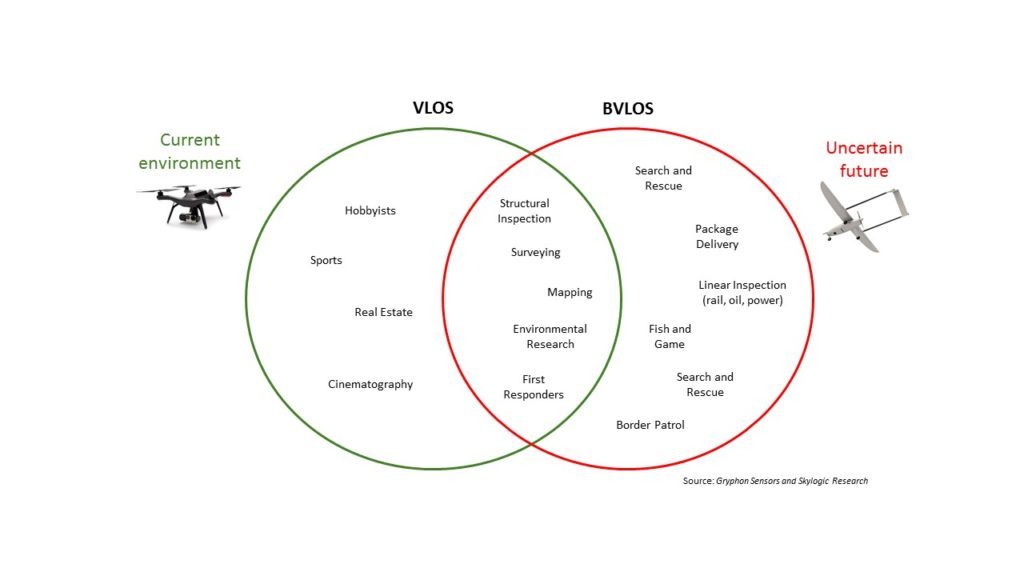Barriers to entry are lower, but high margin operations are still restricted.
QuickTake
THE FACTS: By now you probably know that the Federal Aviation Administration (FAA) has finally released Part 107, the Small UAS Rule (June 21, 2016), which covers operational use of commercial drones in U.S. airspace. This comes after several years of missed deadlines. You can read the FAA’s own summary of the ruling here. What’s important to note is these rules won’t be implemented until late August 2016.
WHAT’S COOL AND WHAT’S NOT: There’s not much difference between what was proposed in the Notice of Proposed Rule Making (NPRM) in February, 2015 and the final rule. In a nutshell, the new U.S. rule is a one-size-fits-all approach that allows commercial operators to fly drones that weigh 55 lbs. or less within visual line-of-sight (VLOS) only and without obtaining a pilot’s license but with the requirement that they pass a test.
(Click on image for larger version. Click “Back button” to return to story.)
Our initial February 2015 economic assessment of the NPRM FAA Proposed Drone Rules: Market Opportunity Winners and Losers looked at the business impact and market opportunities the proposed VLOS rules would have for drone manufacturers, distributors, service providers, and investors. Having read the newly issued Part 107, we stand by our earlier assessment and summarize it here:
- Precision Agriculture – Winner and Loser
Demand for turnkey drone systems will increase as farmers and service providers work within the rule constraints. However, the big caveat is drone usage alone will not “transform agriculture” just yet. For that, we would need to see a change in the adoption rate for variable rate technology (such as applicators) — which is currently down. Read our in-depth review The Truth about Drones in Precision Agriculture.
- Inspection / Monitoring – Big Winner
Demand for and use of drones (especially multirotors) dedicated to asset and infrastructure inspection will see a big uptick. The new rule allows you to fly higher than 400 feet above ground level (AGL) if you stay within 400 feet of a structure (such as a 1000-foot tower), so energy, utilities, and telecommunications infrastructure stand to benefit. The rub is you can’t do night operations. So, roof inspections with a thermal camera is limited to almost useless daytime operations.
- Mapping / Surveying – Winner and Loser
The surveying industry has the most to gain here. The door is wide open for drone operations like stockpile measurement and small open pit mine mapping. The door is also open for laser scanning, 3D imaging capture, and data processing that architectural engineering firms can consume. As such, there are new opportunities for dedicated and differentiated cloud-based in-memory processing data services.
- Film / Photo / Video – Big Winner
Drones have already created new sources of demand for aerial photography, and this will continue in earnest. As with land-based photography, the financial and technical barriers to entry are low, making it easy for businesses to begin offering sUAS-based film and photography services. Now that the regulatory hurdle is low, expect aircraft vendors and specialty retailers to flourish, too.
- Public Safety / First Responders – Uncertain
Under the proposed rules, demand for turnkey drone solutions and services for police, fire, and emergency medical services is uncertain. Operations at night – perhaps when they are needed the most – are restricted. Technology adoption by fire and rescue may be good, but adoption by local and state police agencies will no doubt be fraught with continued controversy over privacy and Fourth Amendment rights. For more information I recommend you read 3 Things Public Safety Officials Should Know about Drones.
THE COMPETITION: A lot can be said about how drone leaders and service providers underestimate the power of competitive incumbent technologies (like satellite and manned aircraft). But there is one type of competition in the commercial drone space that doesn’t get talked about a lot, and it’s this: Now that Part 107 has been released, it will lower the barrier to entry for new drone pilots and service providers.
In theories of economic competition, barriers to entry are obstacles that make it difficult to enter a given market. Since the rules have come in as proposed—that is, with no pilot’s license required for the operator—then the barrier to entry for commercial drone services just got lowered. It’s only natural that we’ll see an uptick of new entrants (they just have to take a test) and we’ll see downward price pressure for services offered.
We see this as a major disruption to the drone service provider market and those already operating under a Section 333 exemption. These firms will suddenly face more competition, whether their business is real estate photography or infrastructure inspection. There simply will be more drone pilots and more drone service providers, and with that the law of demand and supply kicks in. The more supply you have, the lower prices go.
BOTTOM LINE: Markets and businesses love regulation clarity – and with Part 107 we now have that. But we are far away from an inflection point of “drones taking off” — if there is one. The inability to fly over people or beyond visual line-of-sight (BVLOS) restricts some high-margin operations. Because of this, in one sense we have reached a plateau. This rule took a total of 10 years to get. No one knows how long the next one will take.
 Colin Snow is CEO and Founder of Skylogic Research, LLC (aka Drone Analyst®), a research, content, and advisory services firm for the commercial drone industry. Colin is a 25-year technology industry veteran with a background in market research, enterprise software, electronics, digital imaging, and mobility.
Colin Snow is CEO and Founder of Skylogic Research, LLC (aka Drone Analyst®), a research, content, and advisory services firm for the commercial drone industry. Colin is a 25-year technology industry veteran with a background in market research, enterprise software, electronics, digital imaging, and mobility.
Alan is serial entrepreneur, active angel investor, and a drone enthusiast. He co-founded DRONELIFE.com to address the emerging commercial market for drones and drone technology. Prior to DRONELIFE.com, Alan co-founded Where.com, ThinkingScreen Media, and Nurse.com. Recently, Alan has co-founded Crowditz.com, a leader in Equity Crowdfunding Data, Analytics, and Insights. Alan can be reached at alan(at)dronelife.com








nicely done, Colin.
Thanks Mike!
Is there a class of drone pilot that is allowed to conduct BVLOS and night operations?
Apparently not, but the new rule hints these operations can conducted with a grant of exemption. See info here: http://dronelawsblog.com/
Colin is right. You cannot operate at night (after EENT or prior to BMNT) or conduct BVLOS under 107…. Unless you file for a specific COA asking to do so. Be prepared to have mitigation procedures in place (small operating space, back up spotters to test out the bvlos, etc). If you need more info feel free to reach out. I know teams that have done it legally.
You are correct on both counts. The salient issue is exactly as you’ve stated. Roof temperatures rise during daylight as a result of light absorption and potentially minimizing temperature differences between escaping warm air. Therefore it’s better to do thermal inspections at night.
Can you please clarify the comment “So, roof inspections with a thermal camera is limited to almost useless daytime operations.” Thermal camera inspections do not care if the sun is up or not. Or is the statement with regards to roof temperatures rising during daylight as a result of light absorption and potentially minimizing temperature differences between escaping warm air?